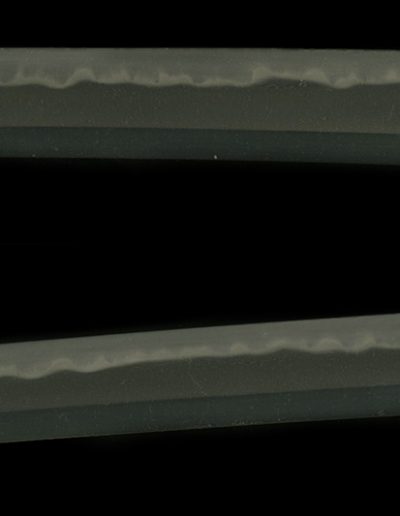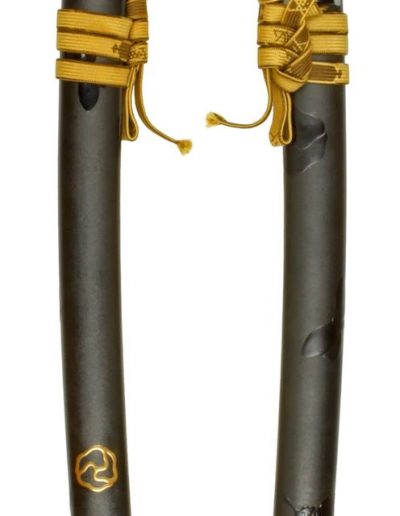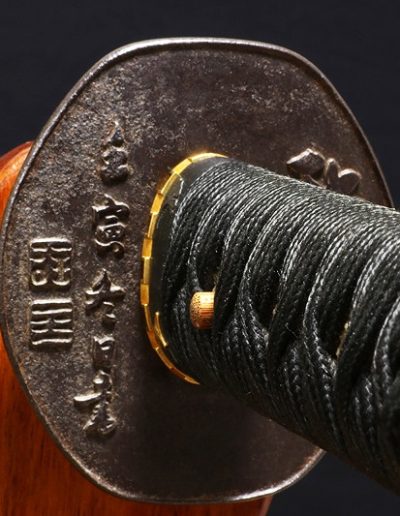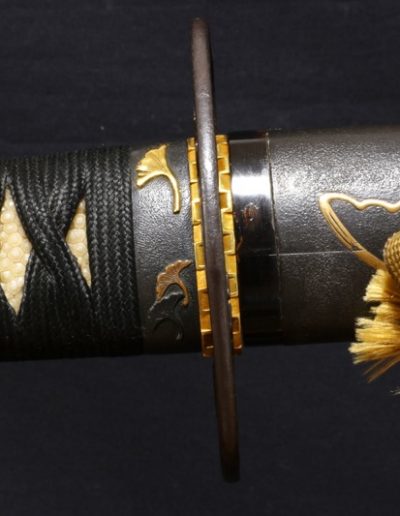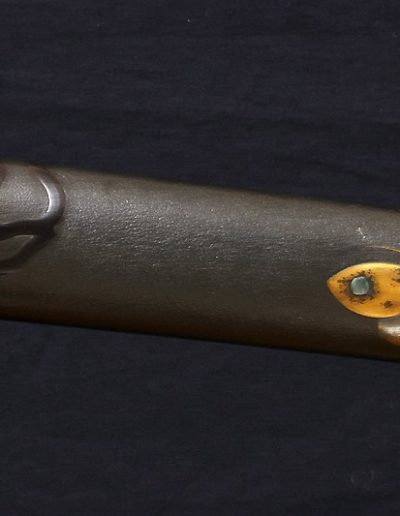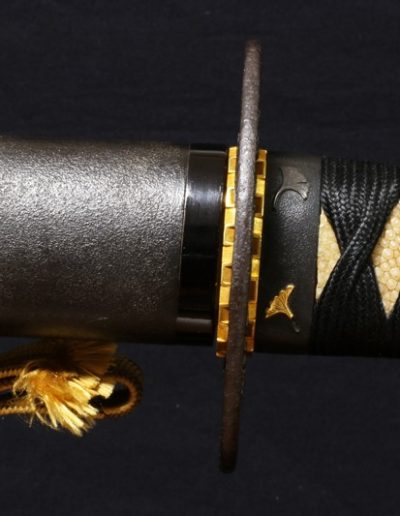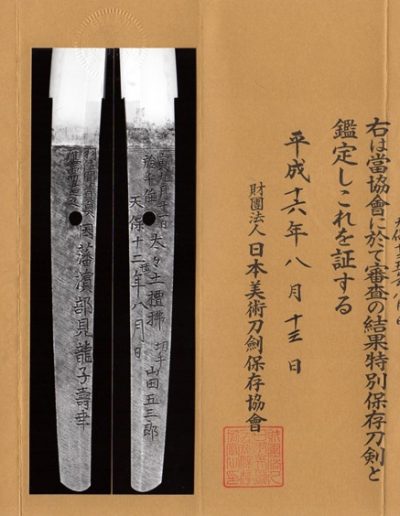Katana, signed: Hazama Sukesada no ōju kore o tsukuru, Inhan Hamabe Kenryūshi
Toshiyuki, Tenpō jūni ushidoshi hachigatsu hi ‒ Tora kugatsu jūichinichi
Senju ni oite taitai dotan–barai kirite Yamada Gosaburō
(羽佐間資貞応需造之・因藩浜部見龍子寿幸・寅九月十一日於千住・
太々土壇拂切手山田五三郎・天保十二丑年八月日)
“Made by the Inaba retainer Hamabe Kenryūshi Toshiyuki on request of
Hazama Sukesada on a day in the eighth month of Tenpō twelve (1841),
year of the ox. Tested by Yamada Gosaburō on the eleventh day of the
ninth month in the year of the tiger [1842] in Senju by cutting through a
body at the height of the collarbones and into the earthen mound below.”
nagasa ~ 63.6 cm
Koshirae
Kuro ishime–nuri kochō–kamon–chirashi saya uchigatana–koshirae (黑石目塗胡蝶家紋散鞘
打刀拵) ‒ Uchigatana–koshirae featuring saya with black stone surface lacquer finish and a
décor of butterfly crests
Tsuba : Decorated with writings from the Analects of Confucius, signed: Toshiyuki kitaeru
Masayoshi horu Hazama Sukesada ōju (寿幸鍛正義彫・間資貞応需) ‒ “Forged by
Toshiyuki and engraved bo Masayoshi on request of Hazama Sukesada”
Fuchigashira : Depicting an arrangement of ginkgo leaves, unsigned
Menuki : Depicting oxen
Tsuka : Covered with white same and wrapped moro–tsumami–maki style with black cord
Tsuba Translation
Signature on obverse:
間資貞・應需
Hazama Sukesada – Ōju
“On request of Hazama Sukesada”
Signature on reverse:
壽幸鍛・正義彫
Toshiyuki kitaeru – Masayoshi horu
“[Plate] forged by Toshiyuki, engraved by Masayoshi”
Inscription on obverse
邪
Yokoshima
壬寅冬⽇書
Mizunoe-tora tōjitsu sho
“Written on a winter day in the year of the tiger (1842)”
Inscription on reverse
思無
Omoi nashi
Note: The inscription of obverse and reverse have to be combined to create the proverb Omoi
yokoshima nashi (思邪無), which means “no wicked thought” or “have no depraved thoughts”
and which goes back to Confucius
TOSHIYUKI (寿幸), Tenpō (天保, 1830-1844), Inaba/Edo – “Toshiyuki” (寿幸), “Hamabe Kenryūshi Toshiyuki
tsukuru” (浜部見龍子寿幸造), “Efu ni oite Hamabe Kenryūshi Toshiyuki tsukuru” (於江府浜部見龍子寿幸造),
“Bushū Naruko ni oite Hamabe Kenryūshi Toshiyuki kore o tsukuru” (於武州成子浜部見龍子寿幸造之, “made by
Hamabe Kenryūshi Toshiyuki in Naruko in Musashi province”), real name Hamabe Watomi (浜部和十郎), he was born
in the first year of Bunka (文化, 1804) as son of Hamabe Toshizane (寿実) in Tottori (鳥取) in Inaba province, his gō
was Kenryūshi (見龍子) and he was the 3rd gen. Hamabe, he also worked in Edo and died on the 21st day of the ninth
month Ansei three (安政, 1856) at the age of 53, dense ko-itame which tends to muji, chōji with a sugu-yakidashi, suguha, also
gunome-chōji, chūjō-saku





